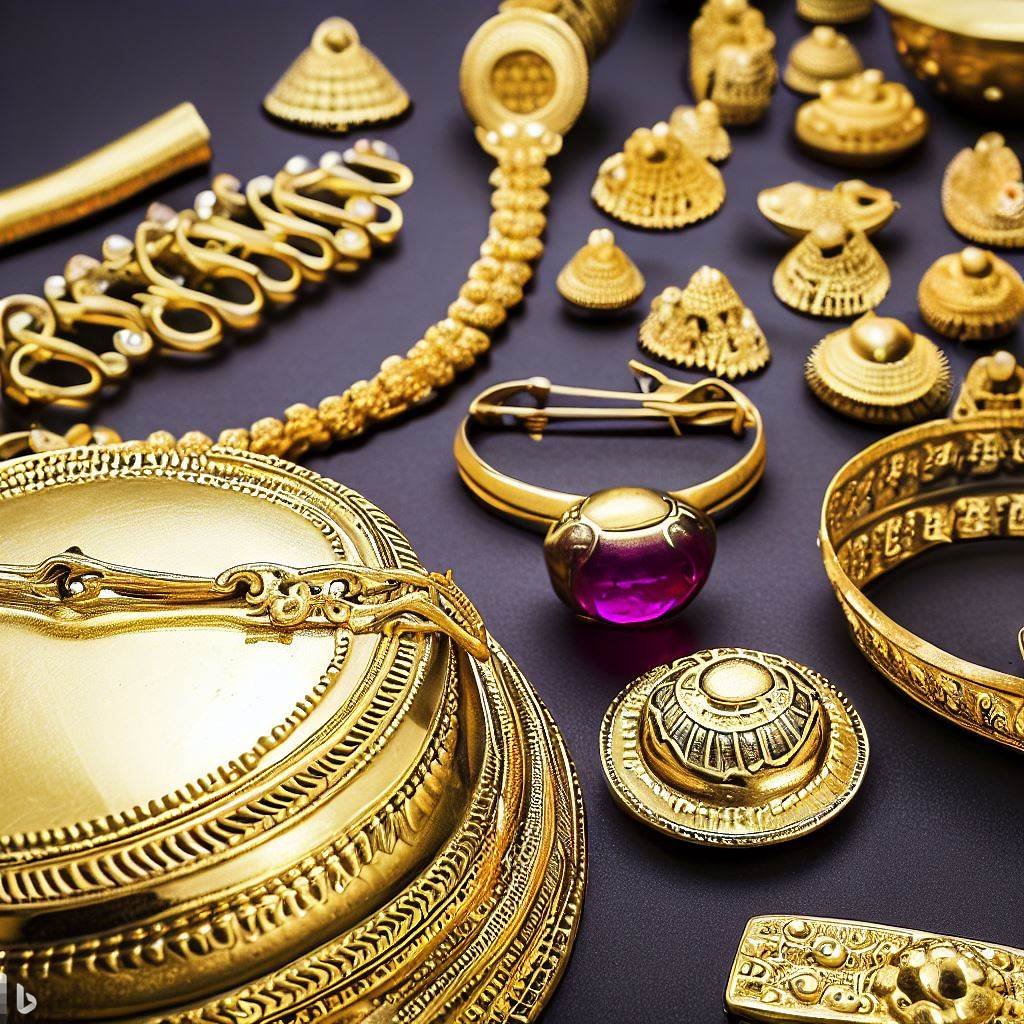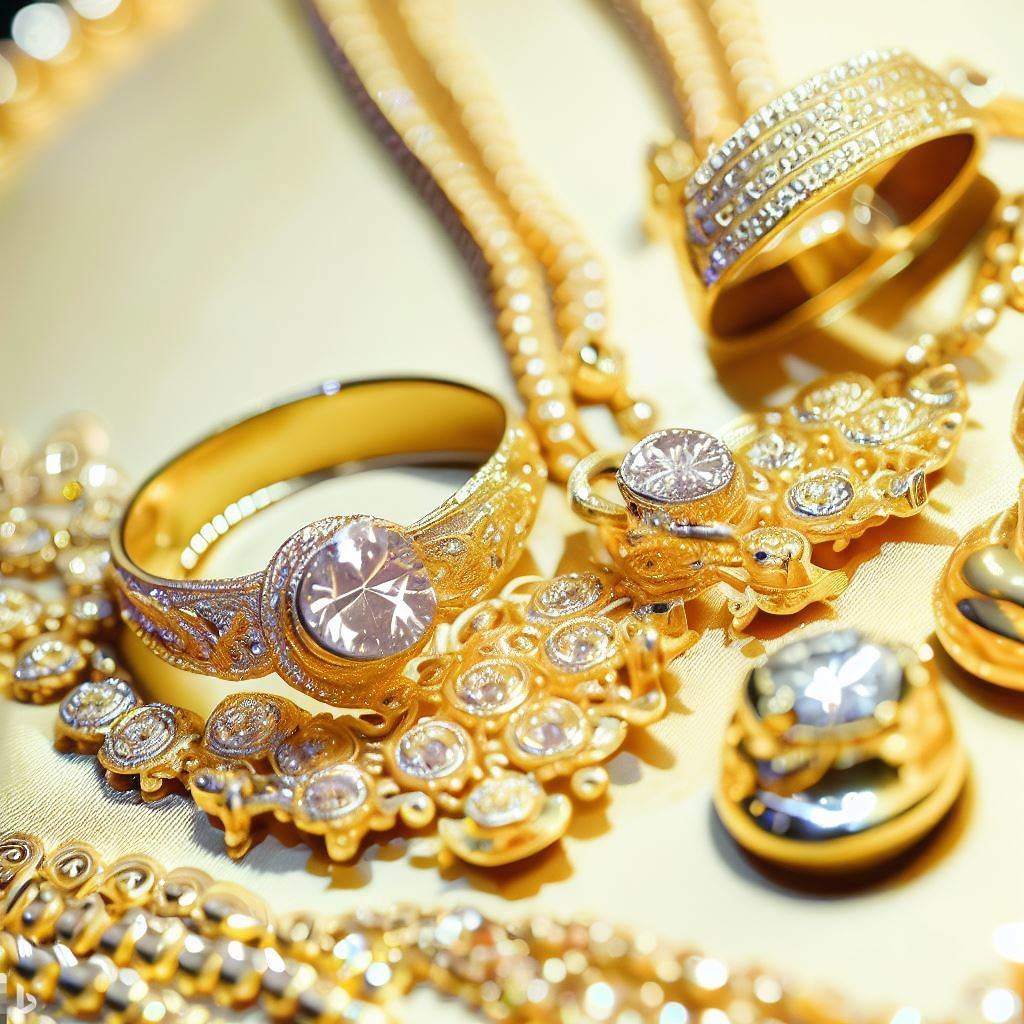Gold has been an essential material in the jewelry industry for centuries. Its enduring beauty and versatility have captivated jewelry enthusiasts around the world, making it a popular choice for creating exquisite pieces that stand the test of time.
From classic designs to modern trends, gold jewelry continues to hold a special place in the hearts of those who seek both sophistication and elegance in their accessories.
Key Takeaways about Role of Gold Jewelry
- Gold jewelry has been significant in various cultures for thousands of years, symbolizing wealth, status, and power.
- Ancient civilizations like the Egyptians and Hindus used gold jewelry in religious and cultural ceremonies.
- The craftsmanship of goldsmithing involves complex techniques and alloys to create diverse designs.
- Contemporary trends in gold jewelry include minimalist styles, statement pieces, and personalized designs.
- Gold jewelry remains a popular investment, offering both aesthetic and financial value.
Whether worn as a statement piece or a subtle touch of glamour, gold jewelry has a unique ability to complement any outfit or occasion. It symbolizes luxury, wealth, and elegance, making it a coveted material in the world of fashion.
We will explore the significance and impact of gold in jewelry, from its history to the latest trends and styles. We will also provide essential tips for caring for gold jewelry and offer insights into how it can be viewed as an investment.
The History and Cultural Significance of Gold Jewelry
Gold has been used in jewelry for thousands of years, with its discovery dating back to ancient civilizations. The use of gold jewelry has been culturally significant and carries symbolic meaning in various cultures around the world.
Ancient Egyptians believed gold was the flesh of the gods and used it extensively in their jewelry, often burying their royalty adorned in gold. In Greece, gold was worn as a symbol of power and social status, while in Rome, it was seen as a symbol of wealth and prosperity.
Gold jewelry has also played a significant role in religious ceremonies and traditions. In Hinduism, gold is considered a sacred metal and is often used to adorn statues and temples. It is also an important part of weddings and other celebrations in Hindu culture. Similarly, in Christian traditions, gold is often used in crosses and other religious symbols, symbolizing the purity and divinity of Christ.
The Symbolism of Gold Jewelry

Gold is often associated with wealth, power, and success, and its use in jewelry embodies these qualities. It is also a symbol of love and commitment, making it a popular choice for engagement rings and wedding bands.
The symbolism of gold jewelry varies by culture, with some associating it with spirituality, while others see it as a symbol of good luck or protection. Regardless of the specific symbolism, gold jewelry holds a special place in the hearts and minds of people all over the world.
The Evolution of Gold Jewelry
Over time, the styles and designs of gold jewelry have evolved, reflecting the changing tastes and preferences of people throughout history. From simple, elegant designs to intricate, highly detailed pieces, gold jewelry has remained a popular choice for both men and women.
Today, gold jewelry continues to be a popular choice for special occasions and everyday wear, with contemporary designs incorporating new materials and techniques. While the styles may change, the enduring beauty and cultural significance of gold jewelry remains.
The Different Types of Gold Used in Jewelry
Gold is one of the most sought-after materials in the world of jewelry. Its natural beauty and lustrous shine make it a popular choice for creating exquisite pieces that stand the test of time.
However, did you know that not all gold is created equal?
In fact, there are different types of gold used in jewelry that vary in color, purity, and durability.
Let’s take a closer look.
Gold Alloys
Gold jewelry is typically made from a gold alloy, which is a combination of pure gold and other metals. These metals are added to improve the strength, durability, and color of the gold.
The most common gold alloys used in jewelry are:
| Gold Alloy | Composition |
|---|---|
| 18K Gold | 75% gold, 25% other metals |
| 14K Gold | 58.5% gold, 41.5% other metals |
| 10K Gold | 41.7% gold, 58.3% other metals |
The percentage of gold in an alloy is measured in karats (K), with 24K being pure gold. The higher the karat, the more pure gold the alloy contains.
While 24K gold is considered the purest form of gold, it is too soft to be used in jewelry, which is why lower karat alloys are used instead.
The Colors of Gold
The color of gold can vary depending on the metals added to the alloy. The three most popular colors of gold used in jewelry are:
- Yellow Gold: the natural color of gold, created by mixing pure gold with silver, copper, and zinc.
- White Gold: created by mixing pure gold with white metals such as nickel, palladium, or silver. It is often plated with rhodium to enhance its shine.
- Rose Gold: created by mixing pure gold with copper, giving it a warm, pinkish hue.
Each color of gold has its unique properties, allowing for a variety of styles, designs, and preferences.
Overall, the type of gold used in jewelry depends on the desired color, durability, and purity level. With the variety of options available, gold jewelry can be customized to suit any taste or occasion.
The Craftsmanship and Techniques Behind Gold Jewelry
Gold jewelry is more than just a pretty accessory. It is a testament to the skills and artistry of the craftsmen who create these exquisite pieces.
From the intricate designs to the selection of materials, the craftsmanship and techniques used in making gold jewelry play a significant role in its beauty and value.
The Art of Goldsmithing
Goldsmithing is an ancient art that dates back to the time of the Egyptians and Greeks. The practice involves working with gold and other precious metals to create a variety of jewelry pieces, including rings, bracelets, necklaces, and earrings.
Goldsmiths use a range of tools and techniques such as soldering, piercing, filing, and polishing to shape the metal into the desired design. They may also incorporate other materials such as gemstones, enamel, and glass to enhance the piece’s visual appeal.
Intricate Designs and Jewelry-Making Techniques
One of the defining features of gold jewelry is the intricate designs that can be achieved through various jewelry-making techniques. From filigree to granulation, goldsmiths have developed a range of methods to create unique and stunning jewelry pieces.
Filigree involves twisting and curling thin wires of gold into ornate designs that resemble delicate lace. Granulation, on the other hand, involves fusing tiny gold beads to the surface of a piece to create a textured effect.
Other techniques include enameling, engraving, and stone setting, each of which requires a high level of skill and attention to detail.
The Value of Handcrafted Gold Jewelry
While technological advancements have made it possible to mass-produce jewelry, there is still a significant demand for handcrafted gold jewelry. These pieces are unique, and the craftsmanship involved in their creation adds to their value.
Handcrafted gold jewelry also allows for a higher level of customization. Customers can work with a goldsmith to create a piece that is tailored to their specific requirements, whether that be a unique design or the incorporation of a specific gemstone.
Overall, the craftsmanship and techniques involved in creating gold jewelry play a significant role in its beauty, value, and desirability. The art of goldsmithing is a time-honored tradition that continues to produce stunning pieces that stand the test of time.
Gold Jewelry for Special Occasions

Gold jewelry has always been a popular choice for special occasions, especially weddings, anniversaries, and other celebrations. There is a reason why gold has been considered the metal of love and commitment for centuries. It symbolizes strength, permanence, and devotion, making it the perfect choice for marking significant milestones in life.
Gold jewelry for weddings is perhaps the most common use of this precious metal. Couples often exchange gold rings as a symbol of their love and commitment to each other. These rings also serve as a reminder of the special day and the love shared between partners.
Similarly, gold jewelry is commonly gifted on anniversaries. It can be a perfect way to show your partner how much you appreciate and love them. A piece of gold jewelry can be a meaningful and heartfelt gift, one that will stand the test of time.
Gold jewelry can also be the perfect choice for other celebrations such as graduations and birthdays. A piece of gold jewelry can be a timeless gift that will continue to hold its value and meaning for years to come.
Whether it be a simple chain or an elaborate necklace, gold jewelry is a classic and elegant way to mark a special occasion. It is a versatile metal that can be paired with any outfit and can be worn for years to come. With so many options available, it is easy to find that perfect piece of gold jewelry that will make any occasion even more special.
Trends and Styles in Gold Jewelry
Gold jewelry has been a fashion staple for centuries, but the styles and trends are constantly evolving. As we move towards a more contemporary jewelry aesthetic, here are some of the latest trends in gold jewelry.
Contemporary Designs
Contemporary designs are all about breaking away from traditional styles. Modern pieces often feature geometric shapes, abstract designs, and bold, statement pieces that make a statement. From sleek and minimalist pieces to chunky and bold, there’s something for every taste.
Minimalist Jewelry
Minimalist jewelry is an all-time favorite due to its simplicity and versatility. Clean, understated designs make these pieces perfect for everyday wear. A simple gold chain or bangle can help elevate any outfit.
Statement Pieces
Statement pieces are bigger, bolder, and more daring. They are meant to be the centerpiece of an outfit, drawing attention and admiration. Statement necklaces, oversized cuffs, and multi-finger rings are all examples of striking pieces that can transform any look.
Personalized Jewelry
Personalized jewelry is on-trend now. A bit of personalization adds something special to a piece, making it even more meaningful. From nameplates to initial pendants, designers are offering an array of options to create a personalized gold jewelry piece.
When it comes to gold jewelry, the possibilities are endless. Whether you prefer contemporary designs or traditional styles, there’s always something to fit your taste.
The Role of Gold in Jewelry
Gold has long been considered one of the most prized materials for crafting exquisite jewelry pieces. Its enduring beauty and versatility make it a popular choice for both classic designs and modern trends. Gold jewelry has stood the test of time, remaining relevant and in-demand throughout the ages.
From simple yet sophisticated pieces to more intricate and ornate designs, gold jewelry has the ability to capture attention and evoke emotion. Whether worn as a symbol of love and commitment or as an accessory to elevate an outfit, gold jewelry is a timeless addition to any collection.
The Role of Gold Jewelry as an Investment
Gold jewelry has long been known for its timeless beauty, but it also has the potential to serve as an investment. The high demand and limited availability of gold make it a valuable commodity that can hold its value over time.
Please watch the video below! An absolute must in the current situation of the economy!
Investing in gold jewelry can be seen as a way to diversify a financial portfolio. While the stock market and other investments can be volatile, gold has historically served as a stable asset. It can be a hedge against inflation, and its value has increased over the long term.
| Financial Value | Market Trends | Collector’s Items |
|---|---|---|
| Gold jewelry is often sold based on its weight and purity level, with higher karat gold being of greater value. The current market value of gold, along with the weight and purity level of the jewelry, determines its financial value. | As with any investment, the value of gold jewelry can fluctuate with market trends. However, it has historically been a stable investment option, with the value of gold increasing over time. Factors such as inflation and economic uncertainty can also have an impact on its value. | Some gold jewelry pieces are considered collector’s items and can hold additional value beyond their weight and purity level. These pieces may have historical or cultural significance, or be rare and sought after by collectors. Examples include antique or vintage gold jewelry, as well as pieces created by renowned jewelry designers. |
When considering gold jewelry as an investment, it is important to do research, seek advice from a financial advisor, and purchase from a reputable source. It is also important to store and maintain the jewelry properly to preserve its value.
Overall, gold jewelry can serve both as a beautiful accessory and a potential investment. Its enduring beauty and value make it a versatile and timeless addition to any collection.
The Frequently Asked Questions About Gold Jewelry
Gold jewelry is a timeless accessory that never goes out of style. While it is often associated with luxury and elegance, many people still have questions about it.
Below are some frequently asked questions about gold jewelry that can help clarify some common queries.
Resources and External Links
Here are some additional resources and external links that can help you:
Articles:
- Why Gold Matters: Everything You Need to Know – Investopedia
- About Gold Jewellery | World Gold Council
- Why Is Gold Important and What If Gold Disappeared? | Goldco
YouTube Videos:
- Why Gold Is The Ultimate Asset For Wealth | The Power Of Gold (Part 1) | Timeline
- Why the Ancient Egyptians weared GOLD JEWELRY – Phosphene
- Is Gold A Good Investment? – CNBC
These resources provide additional information and ideas about the role of gold jewelry.








